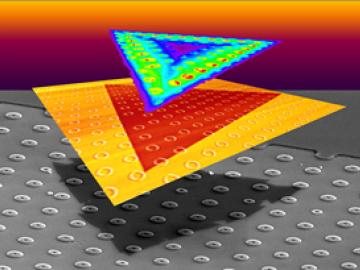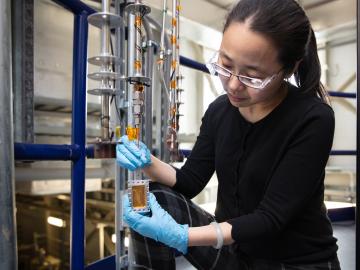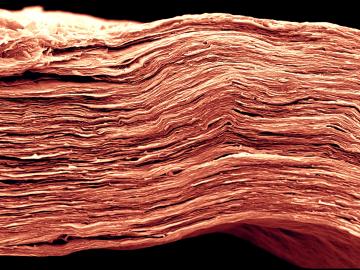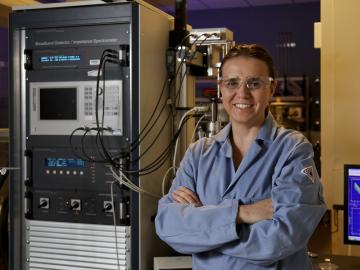
Filter News
Area of Research
- (-) Computational Engineering (2)
- (-) Materials (71)
- Advanced Manufacturing (8)
- Biology and Environment (53)
- Building Technologies (2)
- Computer Science (11)
- Electricity and Smart Grid (3)
- Energy Science (156)
- Energy Sciences (2)
- Functional Materials for Energy (2)
- Fusion and Fission (7)
- Fusion Energy (1)
- Isotopes (1)
- Materials for Computing (13)
- Mathematics (1)
- National Security (21)
- Neutron Science (21)
- Nuclear Science and Technology (1)
- Quantum information Science (9)
- Sensors and Controls (1)
- Supercomputing (53)
News Topics
- (-) Clean Water (4)
- (-) Composites (9)
- (-) Energy Storage (34)
- (-) Grid (5)
- (-) Machine Learning (6)
- (-) Polymers (17)
- (-) Quantum Science (11)
- 3-D Printing/Advanced Manufacturing (23)
- Advanced Reactors (4)
- Artificial Intelligence (10)
- Big Data (3)
- Bioenergy (11)
- Biology (4)
- Biomedical (8)
- Buildings (5)
- Chemical Sciences (32)
- Computer Science (20)
- Coronavirus (4)
- Critical Materials (13)
- Cybersecurity (4)
- Environment (16)
- Exascale Computing (2)
- Frontier (3)
- Fusion (7)
- High-Performance Computing (5)
- Irradiation (1)
- Isotopes (13)
- ITER (1)
- Materials (73)
- Materials Science (78)
- Mathematics (2)
- Microscopy (27)
- Molten Salt (3)
- Nanotechnology (39)
- National Security (3)
- Neutron Science (33)
- Nuclear Energy (16)
- Partnerships (11)
- Physics (28)
- Quantum Computing (3)
- Security (2)
- Simulation (1)
- Space Exploration (2)
- Summit (3)
- Transportation (14)
Media Contacts

A study led by Oak Ridge National Laboratory explored the interface between the Department of Veterans Affairs’ healthcare data system and the data itself to detect the likelihood of errors and designed an auto-surveillance tool

A team led by scientists at the Department of Energy’s Oak Ridge National Laboratory explored how atomically thin two-dimensional (2D) crystals can grow over 3D objects and how the curvature of those objects can stretch and strain the

OAK RIDGE, Tenn., May 7, 2019—Energy Secretary Rick Perry, Congressman Chuck Fleischmann and lab officials today broke ground on a multipurpose research facility that will provide state-of-the-art laboratory space

Researchers at the Department of Energy’s Oak Ridge National Laboratory, Pacific Northwest National Laboratory and Washington State University teamed up to investigate the complex dynamics of low-water liquids that challenge nuclear waste processing at federal cleanup sites.

Ionic conduction involves the movement of ions from one location to another inside a material. The ions travel through point defects, which are irregularities in the otherwise consistent arrangement of atoms known as the crystal lattice. This sometimes sluggish process can limit the performance and efficiency of fuel cells, batteries, and other energy storage technologies.


Vera Bocharova at the Department of Energy’s Oak Ridge National Laboratory investigates the structure and dynamics of soft materials.

Oak Ridge National Laboratory scientists studying fuel cells as a potential alternative to internal combustion engines used sophisticated electron microscopy to investigate the benefits of replacing high-cost platinum with a lower cost, carbon-nitrogen-manganese-based catalyst.

Scientists at the Department of Energy’s Oak Ridge National Laboratory have created a recipe for a renewable 3D printing feedstock that could spur a profitable new use for an intractable biorefinery byproduct: lignin.

Carbon fiber composites—lightweight and strong—are great structural materials for automobiles, aircraft and other transportation vehicles. They consist of a polymer matrix, such as epoxy, into which reinforcing carbon fibers have been embedded. Because of differences in the mecha...


